The main rule about building railways is simple: Railways are no rollercoasters. As in reality, climbing up hills with trains is very time consuming and should be avoided if possible. It might be a good choice to go around a mountin instead of trying to tackle it. Still, in many cases you will need to terraform and build bridges or tunnels, which is quite realistic.
Slopes
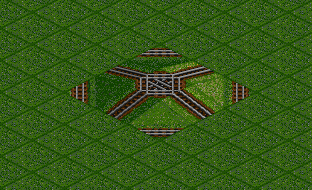
The image shows the building options that the original game offered. Tiles can only be built directly on the ground. This is a very rigid limitation, especially in hilly terrain.
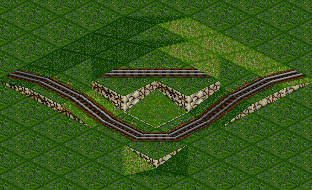
With the Patch, rails can be built in significantly more ways. The foundations underneath are built automatically.
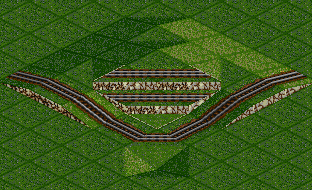
In OpenTTD, building on slopes is also possible, the slopes here allow even more building variations.
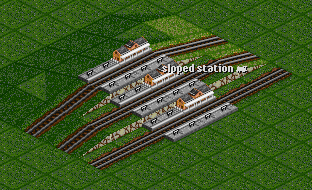
A very neat side effect of this switch is the possibility to build stations on differing height levels.
Bridges
Originally, bridges in TTDX were extremely limited, since they were only allowed to be exactly one square above ground level, and their length was also limited quite heavily. With TTDPatch, higher and longer bridges are possible, as well as replacing the standard types with newly created ones. Despite all modifications, bridges still have some limitations:
- no curved or sloped bridges are possible
- speed limit, depending on the type of bridge (trains start to accelerate above that limit as soon as the leading engine has left the bridge)
- length limit of 127 tiles, this is half the map and should be more than enough
- bridges cannot cross, even if being on different height levels
- signals cannot be placed on bridges
- the terrain under a bridge must not have so-called steep slopes (the parts of hills where one corner of a tile is two height levels below the other corner)
- signals cannot be placed under bridges
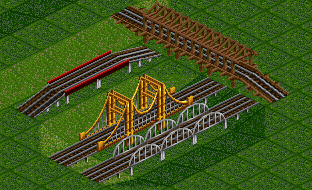
The possibilites for bridges were extremely limited in the original game and made playing in difficult terrain almost impossible.
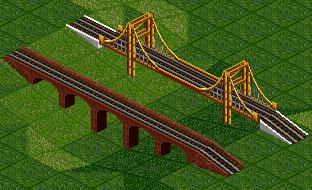
Today, one can build higher and longer bridges as well as use new bridge types. I would say that this addition is among the most important of them all, because this finally enables the player to really play on mountaineous terrain.
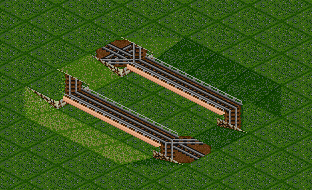
In some cases, extremely compact layout are necessary. This is possible with custom bridge heads, which allow the player to build additional tracks on the bridge ramp.
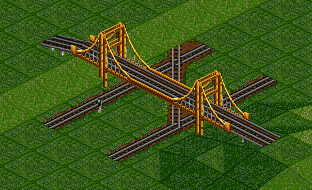
One can also build diagonal rails and junctions below bridges.
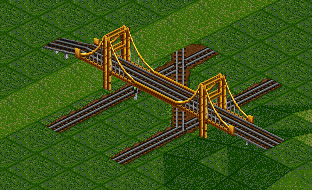
In OpenTTD one can build diagonal rails, junctions and signales below bridges, so just about everything can be built there.
Tunnels
Tunnels are used to go through mountains or to dive under obstacles like towns. The terrain above a tunnel can be used without any limitations. However, tunnels are limited in some ways as well.
- start and end are at the same level, the tunnel always goes straight and does not turn
- tunnels cannot cross if being on the same height level (depending on settings)
- there cannot be any signals inside tunnels
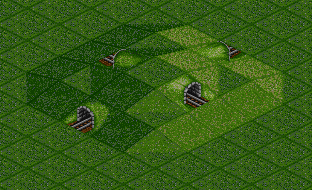
These are the standard tunnels, as they were available in the original game. They go straight from one side of the mountain to the other one, and that's it.
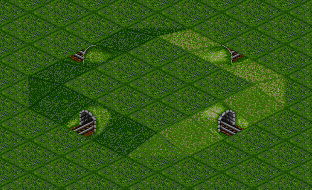
With the Patch, crossing tunnels are possible. However, if you want to play realistically, you should only build crossing tunnels if they have a certain length. Two short tunnels of three tiles including the portals just do not look right when crossing each other. In OpenTTD, building crossing tunnels is only possible when activating the appropriate cheat.
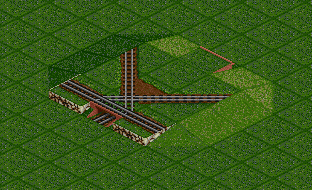
For complex networks where space is scarce, it might be very helpful if one could built above the tunnel portal. By now, one can also build junctions on the tunnel portal. However, you may not build signals there.
When using the original tunnel graphics, any rails above the portal seem to hang in the air, which looks rather awkward, so I use a different graphics set here.
Curves
TTDPatch introduces a realistic acceleration model, which has some effects on curves and especially mountains. The handling of corners is explained quite easily: For each corner that a train is going through at a given moment, the train's top speed is reduced by 1/16, i.e. if the train goes through one corner, the top speed would be 15/16, for two corners it would be 14/16, and so on. This has very drastic effects on fast trains, which have to slow down much more than slower trains. It also hits long trains harder, because it takes them longer to go through a corner completely. Additionally, they might enter the next corner before having left the first one, which will rarely happen with short trains.
It would be more realistic if corners would allow a certain speed, so if the top speed of a train is below that threshold, it does not have to slow down. Maybe this will be introduced one day, until then, make sure that there are no unnecessary turns in your layouts, especially if you have high speed trains.
In OpenTTD the maximum speed of a train is limited, when two curves going in the same direction follow behind each other. Therefore, fast trains can only keep up their pace when the distances between the curves are increased, so basically the curve radius has to become larger. This should be kept in mind when building tracks for the first time. This should be done in such a way that faster trains in later times are able to use the line without being limited.
This behaviour mainly influences fast trains, which are slowed down very much on lines with sharp corners, while slower or shorter trains are not affected that much.
Mountains
Designing tracks to climb a high mountain becomes quite a challenge with the realistic acceleration model and the freighttrains switch, because trains can get stuck during the climb. Well, they still go on, but with a speed just above zero, so it takes them forever to climb up even one level. There are several ways to prevent this from happening: Add another engine or shorten the train (which will both decrease your profit), or change the track layout so that it becomes easier for the train to go atop the mountain.
The main idea is to make the slope less steep. The common result is the serpentines one can often find in the mountains. In TTDX, we cannot change the slope itself, therefore a number of flat tiles should be placed between each slope. The actual number of flat tiles is a matter of trial and error, but you are on the safe side if a train can finish climbing one slope before starting into the next one.
Now what about a train going down a mountain? Admittedly, it is very tempting just to build a track straight down. This works in TTDX, but not in reality: No train would ever be able to stop on its downward way on such a steep gradient as the brakes could not handle it. Therefore, if you want to play the realistic way, the principles of going up a hill also apply for trains going down. Usually, you'll then end up having two tracks, one for each direction.
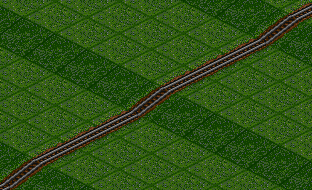
Here, three flat tiles are between each climb. This makes sure that trains with a length up to four tiles never climb two slopes at a time.
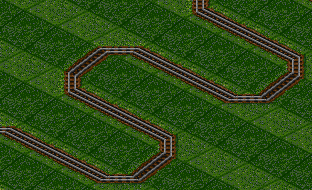
Usually, one will not have the room to build in a straight way as shown in the picture, but has to revert to use more compact layout. Anyone who has been travelling in the mountains should know this one, this simply uses the idea of forming serpentines.
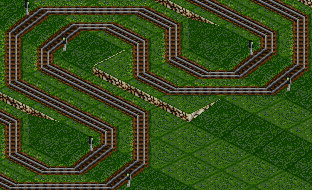
This image shows double tracked serpentines. As one can see, building on slopes becomes vital for saving space here.
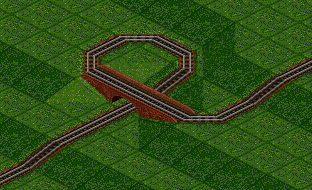
Another method to make it easier for trains to climb hills is this loop construct. Again, the length of track between to slopes is lengthened in order to make the climb easier for a train.
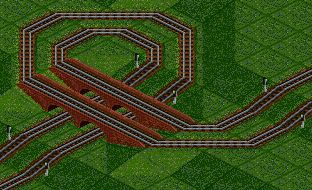
This is a double tracked loop. The outer track is the one going uphill, because the trains going down on full speed should go the shorter way, and it also lengthens the number of flat tiles for the trains going up, allowing them to gain some speed before climbing the next slope.
